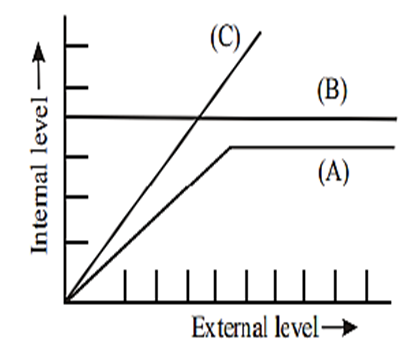 Multiple Choice Questions
Multiple Choice QuestionsIn the equation, where r stands for
Intrinsic rate of natural increase
Death rate
Population density at time t
Carrying capacity
Carrying capacity
Match Column I with Column II and choose the right option.
| Column I | Column II |
| 1. Thomas Malthus | A. Branching descent |
| 2. Hugo deVries | B. Studies on populations |
| 3. Charles Darwin | C. Use and disuse theory |
| 4. Lamarck | D. Saltation |
1 - D; 2 - A; 3 - C; 4 - B
1 - B; 2 - D; 3 - A; 4 - C
1 - B; 2 - D; 3 - C; 4 - A
1 - C; 2 - B; 3 - A; 4 - D
1 - C; 2 - B; 3 - A; 4 - D
The following figure given below is a diagrammatic representation of organismic response to abiotic factors. What do (a), (b) and (c) represent respectively?

(A) Conformers (B) Regulators (C) Partial regulators
(A) Regulators (B) Partial regulators(C) Conformers
(A) Partial regulators (B) Regulators (C) Conformers
(A) Partial regulators (B) Conformers (C) Regulators
(A) Partial regulators (B) Conformers (C) Regulators
C.
(A) Partial regulators (B) Regulators (C) Conformers
In the above graph, A represents partial regulators, B represents regulators and C represents conformers.
Allen's rule applies to
Tribes living in high altitudes
Mammals from colder climates
Fish living in Antarctic waters
Desert lizards
Desert lizards
Pick out the correct option from (a) to (e)
(A) Primary succession begins in areas where natural communities have been destroyed
(B) Hydrarch succession takes place in water
(C) The climax community is the community that is in near equilibrium with the immediate environment
(D) In newly cooled lava secondary succession occurs
(A) and (B) are correct, (C) and (D) are incorrect
(B) and (C) are correct, (A) and (D) are incorrect
(A) and (D) are correct, (B) and (C) are incorrect
(B) only is correct, (A), (C) and (D) are incorrect
(B) only is correct, (A), (C) and (D) are incorrect
Many fresh water animals cannot live for long in sea water mainly because of the
Change in the atmosphere
Change in the levels of thermal tolerance
variations in light intensity
Osmotic problems they would face
Osmotic problems they would face
Match mean annual precipitation in Column I with the biome in Column II and choose the right option.
| Column I | Column II |
| 1. 0-50 cm | A. Tropical forest |
| 2. 50-100 cm | B. Coniferous forest |
| 3. 150-400 cm | C. Grassland |
| 4. 50-250 cm | D. Desert |
1 - D; 2 - C; 3 - A; 4 - B
1 - C; 2 - A; 3 - B; 4 - D
1 - C; 2 - D; 3 - A; 4 - B
1 - B; 2 - D; 3 - A; 4 - C
1 - B; 2 - D; 3 - A; 4 - C
The asscoiation that includes herbivores and phytophagous insects is called
Competition
Parasitism
Predation
Commensalism
Commensalism
The number of individuals of the same species that have come into the habitat from elsewhere during the time period under consideration is known as
Emigration
Mortality
Natality
Immigration
Immigration
In a species, the weight of newborn ranges from 2 to 5 kg. 97% of the newborn with an average weight between 3 to 3.3 kg survive whereas 99% of the infants born with weights from 2 to 2.5 kg or 4.5 to 5 kg die. Which type of selection process is taking place?
Stabilizing Selection
Disruptive Selection
Cyclical Selection
Directional Selection
